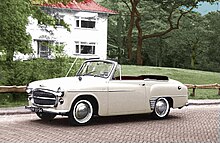Thrupp & Maberly

Thrupp & Maberly was the last British coachbuilder based in the London borough of Cricklewood , which was closely associated with the Rootes Group in the 20th century .
Company history
The company Thrupp & Maberly goes back to a company founded by Joseph Thrupp in London in 1760, which manufactured bodies for carriage wagons. In 1859 George Maberly took part in the company; then the name was changed to Thrupp & Maberly.
In the first years of the 20th century, Thrupp & Maberly shifted its activities to the manufacture of automobile bodies. Initially, individual superstructures were built for exclusive passenger cars, but during World War I mainly troop transporters left the factory halls in London. After the end of the war, Thrupp & Maberly again produced special bodies according to customer requirements, based on chassis from Delage , Hotchkiss and Minerva .
In 1926 Rootes Ltd. the traditional body shop. RI Musselwhite, who had previously managed the Napier- affiliated body manufacturer Cunard for ten years, became plant manager . At that time, Rootes was not a car manufacturer, but a pure dealer selling cars and chassis etc. a. distributed by Austin , Daimler and Rolls-Royce . With the takeover of Thrupp & Maberly, Rootes wanted to give its wealthy customers an opportunity to have the exclusive chassis clad in their own house with an individual body instead of - as before - commissioning external body construction companies. In addition, Thrupp & Maberly continued to serve individual clients between the world wars. By 1930, numerous convertible, coupé and landaulet bodies were built for Alvis , Bentley , Lagonda and Rolls-Royce chassis, most of which remained unique.
After Rootes had become an automobile manufacturer through the takeover of the Hillman and Humber brands in 1931 , Thrupp & Maberly was increasingly entrusted with orders from the group. Up until the outbreak of World War II, Thrupp & Maberly mainly built the bodies for the Humber Pullman , the most exclusive model of the Rootes Group. Special bodies for other manufacturers were only occasionally produced. For the Rolls-Royce Wraith, for example, a total of 42 bodies were produced by 1939.
During the Second World War, vehicles for the British Army were again manufactured in Cricklewood. A Humber Super Snipe from 1943, converted by Thrupp & Maberly and regularly used by Field Marshal Montgomery , achieved some fame .
After the end of the Second World War, Thrupp & Maberly was fully integrated into the Rootes Group. The company gave up the manufacture of exclusive special bodies and in the future produced the standard bodies for certain Rootes models. Initially, this only included the high-priced Humber models such as the Imperial and the Pullman; in their case, Thrupp & Maberly built the entire body structure as well as the outer cladding and finally also carried out the painting. From the mid-1950s, all of the Rootes Group's convertibles were also manufactured; in this case, however, Pressed Steel produced the body-in-white, while Thrupp & Maberly took over the completion of the cars, including the paintwork. Later the production of special coupés like the Hillman Minx Californian and the Sunbeam Rapier was added.
During the 1960s, Thrupp & Maberly's workload decreased. In 1962 and 1964 respectively, Rootes stopped production of the Hillman Minx and the Singer Gazelle , in 1966 the Humber Scepter was discontinued and a year later the Humber Super Snipe and its luxury version Humber Imperial , without any successors for these models. From 1966 Thrupp & Maberly had carried out the painting work for the new Rootes Arrow ; in the summer of 1967, however, Rootes decided to close the now outdated plant. This ended automobile production at Thrupp & Maberly.
Thrupp & Maberly's factory buildings in Cricklewood stood empty long before they were demolished in the 1980s.
The Golden Arrow
A special vehicle manufactured by Thrupp & Maberly in 1928 was the Golden Arrow. It was a gold-painted vehicle with a Napier twelve-cylinder aero engine, with which Henry Segrave set a speed record in Daytona in March 1929: Segrave drove the flying mile at a speed of 372 km / h. The record lasted until February 1931.
Automobile production
In 1896 the company installed an electric motor in one of their carriages and sold this electric car to the Spanish queen. Presumably other vehicles of this type followed.
literature
- Graham Robson : The Cars of the Rootes Group , London 2007, ISBN 978-1903088296
- Jonathan Wood: Rolls-Royce & Bentley. The story of a legendary brand . 1st edition 2003 Königswinter (Heel Verlag GmbH) ISBN 3-89880-106-3 .
- George Nick Georgano (Editor-in-Chief): The Beaulieu Encyclopedia of the Automobile. Volume 3: P – Z. Fitzroy Dearborn Publishers, Chicago 2001, ISBN 1-57958-293-1 . (English)
Web links
Individual evidence
- ↑ Brand portrait on the website www.coachbuild.com , accessed on September 9, 2010.
- ^ Robson: The cars of the Rootes Group, p. 11.
- ↑ Images of individual vehicles on the website www.coachbuild.com , accessed on September 9, 2010.
- ↑ Jonathan Wood: Rolls-Royce & Bentley. P. 69.
- ^ Robson: The cars of the Rootes Group, p. 164.
- ↑ History of the record drive and the car on www.bluebird-electric.com , accessed on September 9, 2010.
- ^ A b Georgano: The Beaulieu Encyclopedia of the Automobile.




